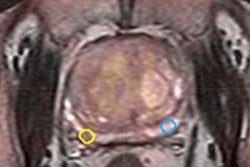
Using multiparametric MRI (mpMRI) to image men suspected of having prostate cancer can reduce unnecessary biopsies by more than a third and increase the detection of clinically significant disease by more than 50%, according to a meta-analysis published online August 7 in JAMA Network Open.
The results offer patients and their clinicians a way to avoid an invasive procedure, said a team led by Martha Elwenspoek, PhD, of University Hospitals Bristol National Health Service Foundation Trust in Bristol, U.K.
"[Our analysis] demonstrates that prebiopsy magnetic resonance imaging combined with targeted biopsy is associated with improved detection of clinically significant prostate cancer and reduced numbers of biopsy cores per procedure, while potentially avoiding unnecessary biopsies," the group wrote.
Current protocol for men with suspected prostate cancer includes biopsy, but many who undergo the procedure have either no disease or low-risk disease that doesn't require treatment, Elwenspoek and colleagues noted. They hypothesized that MRI could help patients avoid unnecessary biopsies.
"Prostate cancer is the most commonly diagnosed cancer in men and the second leading cause of cancer-associated death among men in the United States," the researchers wrote. "Distinguishing high-risk from low-risk prostate cancer remains difficult, leading to overdiagnosis and, for some men, unnecessary invasive treatments and treatment-associated morbidity. There is, therefore, an unmet clinical need to develop tests that can detect clinically significant prostate cancer while reducing overdiagnosis of low-risk disease."
So the team conducted a review to compare systematic transrectal ultrasound-guided prostate biopsy to prebiopsy biparametric or multiparametric MRI, followed by targeted biopsy with or without systematic biopsy. The research included seven randomized clinical trial studies from Medline, Embase, Cochrane, and Web of Science databases that compared the two approaches in men who had not yet had a biopsy but were suspected of having prostate cancer (the seven studies represented 2,582 patients).
Main performance measures included detection rate of clinically significant and insignificant prostate cancer, number of biopsy procedures, number of biopsy cores taken, and complications.
The researchers found that, compared with systematic transrectal ultrasound-guided prostate biopsy alone, prebiopsy MRI with or without a targeted biopsy afterward (depending on MRI findings) was more effective. Specifically, they noted the following benefits of MRI:
- 33% reduction in number of biopsy procedures
- 57% improvement in detection of clinically significant prostate cancer
- 77% reduction in number of cores taken per biopsy
As well, one of the trials showed a reduction in pain and bleeding adverse effects as the result of prebiopsy MRI, the group noted.
The findings suggest that prebiopsy mpMRI should be incorporated into the diagnostic protocol in men with suspected prostate cancer, wrote Dr. Peter Albertsen of the University of Connecticut Health Center in Farmington, in an accompanying editorial.
"The public health crisis of prostate cancer overdiagnosis demands a change in the current prostate-specific antigen screening and biopsy treatment paradigm," Albertsen wrote. "The systematic review and meta-analysis by Elwenspoek et al offers strong support for an alternative approach that calls for a prebiopsy MRI."




.fFmgij6Hin.png?auto=compress%2Cformat&fit=crop&h=100&q=70&w=100)




.fFmgij6Hin.png?auto=compress%2Cformat&fit=crop&h=167&q=70&w=250)











